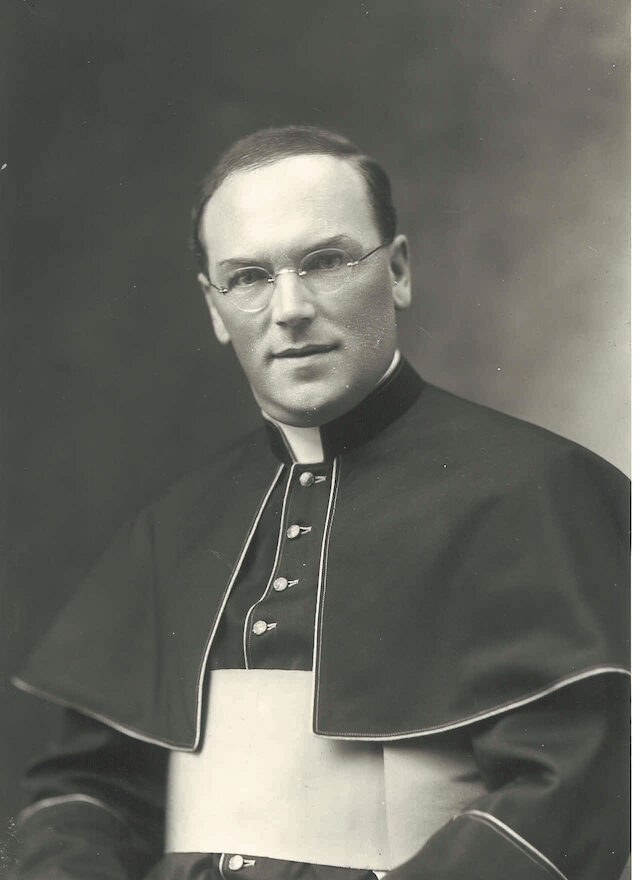On January 27, 2024, this
Zeitpunkt was installed near the address Domplatz 4. The initiative for this came from erinnern:at.
Carl Lampert spent the years of the First World War in the seminary in Brixen. He was ordained as a priest in Brixen Cathedral by Prince Bishop Franz Egger in May 1918. He then served as chaplain in the parish of St. Martin in Dornbirn-Markt until 1930. After studying canon law in Rome, Monsignor Lampert set up the ecclesiastical court in Innsbruck starting in 1935. The following year he also took charge of the Tyrolia publishing house. In January 1939 Lampert became pro-vicar of the new Apostolic Administrature of Innsbruck-Feldkirch.
As deputy to Bishop Paulus Rusch, he was responsible for negotiations with the Nazi regime on behalf of the Church. This made conflict with Gauleiter Franz Hofer inevitable, who did not recognise the appointment of Bishop Rusch and generally pursued a hard line with regard to the Church. He blamed the pro-vicar for the resistance put up by nuns to the closure of the Convent of Perpetual Adoration, and Lampert was held for ten days in the Innsbruck police jail in March 1940. In April, he again spent a short period in custody because of a critical report on Radio Vatican about the suppression of the Church in Tyrol and Vorarlberg.
On 5 July 1940, the Gestapo arrested Lampert for publishing an obituary for Otto Neurer, a priest from Götzens who was murdered in Buchenwald concentration camp. On 25 August, he was deported to Dachau and on 30 August to the Sachsenhausen concentration camp near Berlin. On 15 December 1940, he was transferred back to Dachau and released on 2 August 1941. When Hofer expelled him from the Gau Tirol-Vorarlberg, Lampert moved to Pomerania. He worked as a priest in Stettin, Swinemünde and Parchim. The Gestapo informer Franz Pissaritsch, who used the alias Ing. Georg Hagen, wormed his way into Lampert’s trust. Through visits by a clergyman friend in the seaside resort of Zinnewitz, Lampert came into contact with Dutch and Polish slave labourers from the Peenemünde research station. After divine service, they met at the home of the Sisters of Mary. Gestapo informer Pissaritsch took notes of their conversations and also kept a record of the foreign radio stations the group listened to. On 4 February 1942, the Gestapo arrested Lampert and severely maltreated him. He was also tortured during his months of imprisonment in Halle an der Saale.
On 20 December 1943, the Reich Military Court in Halle sentenced Lampert to death for subversion of the war effort and giving aid and comfort to the enemy. He was kept in chains day and night for weeks until he was transferred to Fort Zinna military prison in Torgau on 14 January 1944. On 24 July 1944, the Reich Military Court in Torgau sentenced Lampert to death for a second time, this time for espionage. When the presiding judge, Werner Lueben, committed suicide the night before the verdict was to be announced in order to avoid having to impose unlawful sentences on Lampert and two other priests, a retrial became necessary for formal reasons. On 8 September 1944, this trial also ended with the death sentence. The decisive factor was the Iies told by Gestapo informer Pissaritsch. He claimed that Lampert wanted to obtain information about the secret weapons being produced in Peenemünde. Dr. Carl Lampert was beheaded in the prison in Halle an der Saale on 13 November 1944.
Sources:
Hormayr, Gisela: „Die Zukunft wird unser Sterben einmal anders beleuchten“. Opfer des katholisch-konservativen Widerstands in Tirol 1938–1945, Innsbruck-Wien-Bozen 2015, S. 151-157.
Gohm, Richard: Selig, die um meinetwillen verfolgt werden: Carl Lampert, ein Opfer der Nazi-Willkür 1894-1944, Innsbruck-Wien 2008.
